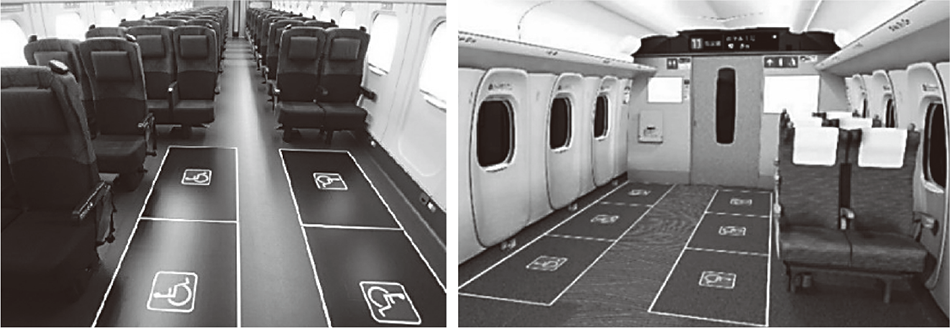The development of Shinkansen rolling stock for use under a variety of different conditions and operating practices has continued over recent years, with a need to address technical challenges in ways that build on the research conducted into making rolling stock lighter weight and more energy-efficient, both crucial requirements for high-speed operation. Examples of the challenges associated with faster speeds include how to minimize internal and external noise and vibration levels during operation, and how to make trains more energy-efficient, smaller size, and lighter weight, and suitable for maintenance. These technologies contribute essential features to the Shinkansen trains used for long-distance travel in Japan, with significant progress being made on punctuality, comfort, and convenience. Among Hitachi’s latest developments for use on the Shinkansen are technologies for reliable high-speed operation that include optimization of the aerodynamics of the leading shape, vehicle noise minimization, traction systems designed for energy efficiency, and improvements in ride comfort. This article describes these latest technologies for Shinkansen trains.

Railways have attracted attention in recent years as a form of public transportation with low energy consumption. Hitachi designs and manufactures rolling stock, traction systems, and switches and other signal and traction equipment for regional, commuter, high-speed, and monorail railway lines. Working in partnership with its production sites in Italy and the UK, it is able to offer a broad range of products.
This article focuses on technologies for reducing the weight of Shinkansen rolling stock and for making their traction systems more energy efficient.
The following section describes how the A-Train concept of double-skin construction using aluminum hollow sections provides a basis for making rolling stock lighter weight, and how the leading-shape design and noise-reduction techniques reduce train travel noise and make it more comfortable.
The subsequent section on traction systems describes the product technologies used in Shinkansen rolling stock, which include induction motors (IMs) with world-class efficiency and an inverter that features a new cooling system and silicon carbide (SiC) power devices that incorporate new materials. The article also presents technologies for making the interior of the train a more comfortable and pleasant place to be by reducing internal noise and improving bogies by enhancing ride comfort.
Among the technical challenges common to all Shinkansen rolling stock are the issues of how to suppress internal and external noise and vibration when trains are in operation, and how to make trains more energy-efficient, smaller size, lighter weight, and suitable for maintenance. Improvements in these areas help improve punctuality, comfort, and convenience. This section describes the latest technologies, focusing on those adopted on Japan’s flagship Shinkansen trains.
Figure 1 — Leading Shape of E5 Shinkansen The leading shape of the E5 Shinkansen is designed for a maximum speed of 320 km/h.
The leading shape of the E5 Shinkansen is designed for a maximum speed of 320 km/h.
Figure 2 — Leading Shape of N700S Shinkansen The figure shows a photograph of the leading car of the N700S Shinkansen (left) and the results of an aerodynamics analysis (right).
The figure shows a photograph of the leading car of the N700S Shinkansen (left) and the results of an aerodynamics analysis (right).
Figure 3 — Shinkansen Traction System The photograph shows a 50/60 Hz converter/inverter (C/I) from the traction system of an E7 Shinkansen.
The photograph shows a 50/60 Hz converter/inverter (C/I) from the traction system of an E7 Shinkansen.
Figure 4 — Shinkansen Traction System The photograph shows the C/I and main motor (MM) from an N700S Shinkansen.
The photograph shows the C/I and main motor (MM) from an N700S Shinkansen.
On consideration for the environment, Hitachi has been working on areas such as rolling stock design, including improvements to the energy efficiency of the traction systems used on the Shinkansen and to the leading shape and external noise.
Figure 5 — Measures for Minimizing External Noise from Shinkansen The photographs show an E5 side cover incorporating sound-absorbing material (left), a sound-absorbing plate from an E5 (middle), and a sound-absorbing plate from an E6.
The photographs show an E5 side cover incorporating sound-absorbing material (left), a sound-absorbing plate from an E5 (middle), and a sound-absorbing plate from an E6.
Figure 6 — High-speed Bogie for E6 Shinkansen The bogie combines ride stability with a reduction in lateral forces when running on conventional railway lines.
The bogie combines ride stability with a reduction in lateral forces when running on conventional railway lines.
Hitachi has sought to improve the ride comfort of its trains through measures that include reducing lateral forces in bogies and minimizing vibration in high-speed running conditions. Enhancements have also been made to the interior design of the Shinkansen rolling stock supplied to railway companies.
Figure 7 — Interior of GranClass Rolling Stock The photographs show the car interior (left) and a front and rear view of the seating (middle and right).
The photographs show the car interior (left) and a front and rear view of the seating (middle and right).
To enable Shinkansen trains to operate at higher speeds, measures have been adopted to improve operating performance and to ensure reliability in high-speed running conditions. The traction system has also been made suitable for maintenance, with improvements to the reliability and durability of the parts used in the different items of equipment. As a result, the system is smaller and quieter than previous models while still delivering the required output. A shift is also underway to condition-based maintenance (CBM) based on the actual operational status of equipment rather than the past practice of time-based maintenance (TBM) whereby elapsed time or distance traveled were the criteria for when to perform work.
Figure 8 — Improvements to Shinkansen Comfort The photographs show light-emitting diode (LED) lighting (left), braille signage (middle), and large toilet (right) on an E7 Shinkansen.
The photographs show light-emitting diode (LED) lighting (left), braille signage (middle), and large toilet (right) on an E7 Shinkansen.
Figure 9 — Shinkansen Barrier-free Accessibility The E7 and N700S Shinkansen provide space for wheelchairs.
The E7 and N700S Shinkansen provide space for wheelchairs.
Steps are also being taken to provide facilities suitable for the physically disabled to improve barrier-free accessibility. Braille signage is located in the deck area to provide information about the interior layout and progress is being made on installing highly convenient equipment designed with accessibility in mind, including many Shinkansen trains being fitted with multi-function wheelchair-accessible toilets (see Figure 8).
This article has described technologies for reducing weight and improving energy efficiency, both essential requirements for Shinkansen trains.
Hitachi intends to continue in its pursuit of technical innovation as it seeks to further improve the performance of Shinkansen rolling stock.